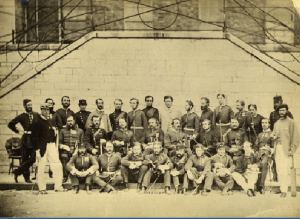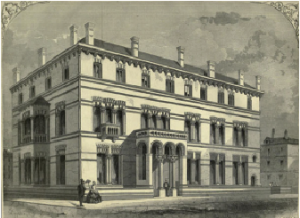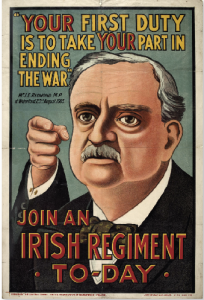A soldier of the queen: General J.P. Redmond
Published in Features, Home Rule, Issue 6 (November/December 2013), Volume 21
Above: Officers of the 61st Regiment of Foot at Raglan Barracks, Devonport, in 1861. Lt. Col. J.P. Redmond is in the middle row, fifth from left. What led Redmond, a Catholic, to serve ‘queen and country’ when so many of his creed and class chose not to? (Soldiers of Gloucestershire Museum)
In March 1902, Lieutenant General J.P. Redmond was buried with full military honours in Guildford cemetery. Officers past and present of his old regiment, the Glosters, sent a ‘magnificent wreath’, and a military carrying party from the 61st bore his body to the graveside. But, despite appearances, this was no ordinary old soldier’s funeral. After all, his family was represented by a man whom the British government had only a few years earlier suspected of being a member of the Irish Republican Brotherhood and whose associates had recently strongly condemned Irish soldiers fighting for Britain against the Boers. The presence of John Redmond MP at his uncle’s funeral was therefore a reminder that General Redmond had been rather an unusual soldier of the queen.
J.P. Redmond had always been different from his fellow officers because he was an Irish Catholic. While Irish Catholics were commonly found in the army’s ranks, its officers were overwhelmingly Protestant. This was a legacy of the British state’s traditional hostility towards Catholics holding positions of responsibility and influence. Although the penal laws had been repealed by 1829, just 3% of British officers were Catholics when Redmond was commissioned in 1842, and even by the time he retired this figure had only reached 4.4%. Irish Catholic officers were therefore a very rare breed indeed. So what led Redmond to serve ‘queen and country’ when so many of his creed and class chose not to?
P.W. Redmond, ‘Orange Catholic’

Daniel O’Connell—personally criticised J.P. Redmond’s father, P.W., for preferring the ‘billiard table and field sports to joining in . . . the great struggle’.
Born into a County Wexford gentry family in 1824, Redmond was the son of P.W. Redmond, a Catholic landlord whose politics became increasingly conservative as he grew older. During the 1820s P.W. Redmond had supported Daniel O’Connell’s Catholic Emancipation campaign, but after 1829, when O’Connell launched the Repeal movement, Patrick Redmond declared that it could not be obtained without ‘revolution, bloodshed and separation’. More controversial still was his attack on the role of the Catholic clergy in politics, which he believed undermined the leadership role that rightfully belonged to the Catholic gentry. This stance ultimately led him to contest the 1835 Wexford by-election as a ‘Whig Tory’ candidate. In his election address he laid ‘claim . . . [to] that constitutional influence which property is entitled to possess’, and courted the support of the ‘landed proprietary’ of County Wexford. He received this, and that of the local Orange Order, but also the enmity of much of the county’s Catholic tenantry and priesthood. Not surprisingly, the election required the intervention of the military in what proved to be a turbulent contest.
While P.W. Redmond saw himself as asserting the rights of leadership conferred by property on Catholic gentlemen, he was denounced as an ‘Orange Catholic’ and as a ‘Catholic pretender . . . to aristocracy’. Daniel O’Connell personally criticised Redmond for preferring the ‘billiard table and field sports to joining in . . . the great struggle’. Indeed, though Redmond lost the election, he became closely associated with the county’s Tory establishment, riding to hounds and serving as a magistrate, high sheriff and deputy lieutenant for County Wexford. In this connection he attended numerous events at Dublin Castle and in 1841 was presented to Queen Victoria. Like some other Catholic gentlemen of the period, Patrick seems to have seen emancipation as an opportunity for the consolidation and advancement of his family’s economic and social position within a union that now extended Catholics the rights due to property.
Family tradition of military service

The Kildare Street Club in 1860—Redmond, a magistrate for County Wexford, was a member of the conservative club.
As well as being influenced by his father’s Toryism, General Redmond’s choice of profession was influenced by a long family tradition of soldiering. The Redmonds claimed to be descended from Raymond Fitzwilliam de Carew, commander of the Anglo-Norman forces that invaded Ireland in 1173. Family lore held that Raymond’s descendants settled in County Wexford and prospered there until their land was confiscated in the seventeenth century. The loss of their estates, combined with the penal laws, forced various family members into becoming merchants at home and soldiers abroad in the armies of Catholic Spain and France.
The family’s military service to the English crown began with General Redmond’s great-great uncle, Walter Redmond, during the 1798 rebellion. Although later generations claimed that the family supported the United Irishmen, Walter was one of a small number of Catholic members of the loyalist Wexford yeomanry that helped suppress the rebellion. And, though never a soldier, Walter’s nephew, the aforementioned P.W. Redmond, was a patron of the Wexford Militia in the 1860s. This military tradition culminated in Patrick’s eldest son, J.P. Redmond, becoming a professional soldier.

J.P.’s nephew, John Redmond MP—his family’s tradition of Catholic loyalty increasingly exerted an influence on him. Redmond’s critics denounced him as a ‘recruiting sergeant for John Bull’ and recalled that he was, after all, the nephew of one of England’s ‘hired assassins’.
Service in India
Commissioned into the 61st Regiment of Foot in 1842, Redmond spent much of his early career in British India. Arriving in Calcutta in 1845, Lieutenant Redmond served throughout the Punjab campaign of 1848–9 and fought at the battle of Chillianwallah. Service in India in the following decade could be frustrating, however, given that the officers of ‘the more fortunate regiments had been earning fame and quick promotion in the Crimea and the recent Persian campaign’, though, as the same officer noted, ‘rackets and billiards, a drive or ride along the mall, and the usual mess dinner’ made Ferozepore in the Punjab a not unpleasant station. ‘We little thought’, he remembered, ‘of the volcano . . . smouldering under our feet.’
The Indian Rebellion or ‘Mutiny’ began on 10 May 1857, but for Redmond and the 61st Regiment it started three days later. On 13 May Redmond and the regiment’s Light Company were guarding the ordnance stores in the Ferozepore Brigade’s magazine when 300 men of the rebellious 57th Native Indian Regiment attacked their position. A party of the 57th was on duty inside the magazine and helped the mutineers to scale the walls with a view to capturing the ammunition within. But the magazine also contained the families of the 61st’s officers, who had sought refuge there after reports of the mutiny had reached Ferozepore the previous day. According to the Glasgow Herald, the attacking force sought entry via the magazine’s entrance, but encountered ‘some six files of the 61st under Major Redmond ready for them; a single volley from these gallant fellows brought down several of the foremost mutineers and the rest fell back and were soon in quick retreat’. In fact, as Sergeant Martin McHarry of the 61st later recalled, ‘some of them stood and fired’, resulting in Redmond’s being wounded in the thigh. Despite his wound, Redmond ordered his men to reload, and after another volley the mutineers retreated and the magazine was reinforced.
In the aftermath of the engagement, the 61st was among those British regiments that executed sepoy prisoners by cannon. As for Redmond, after his recovery he went on to serve at the siege of the insurgent stronghold of Delhi. Afterwards he was a member of the British court that tried the last Mughul emperor of India, Muhammed Bahadur Shah. Returning to Britain, Redmond was promoted lieutenant colonel in 1861 and served with the regiment in his native Ireland in 1865, during which time he was involved in the court-martialling of several suspected Fenians in the regiment. Perhaps out of concern for the loyalty of some of its Irish troops, the 61st was redeployed under Redmond’s command to the West Indies in 1866 and to Canada in 1870. Created a Commander of the Bath in 1869, he retired in 1873 and rose to the honorary rank of general by the time of his death in 1902.
Brother a Home Rule MP
J.P. Redmond was unusual for his time not only in his choice of occupation but also because he was a loyal Catholic during a period when Irish nationalism was coming to dominate Catholic politics in Ireland. Married to Roberta (née Leaf) according to the rites of the Church of England in 1864, Redmond was a magistrate for County Wexford, a member of the conservative Kildare Street Club in Dublin and, like his father before him, loyal to the crown and to the union with Britain.
Other members of the family, however, took a different political stance. Although J.P. Redmond’s brother, William Redmond, was a moderate Home Rule MP (who, like Isaac Butt, stressed his attachment to the British throne and the empire), his sons—Patrick’s nephews John and Willie Redmond—became supporters of Parnell. Willie Redmond resigned his commission in the Royal Irish Regiment in 1881 and as an Irish Parliamentary Party (IPP) MP expressed the hope that Cossacks would one day stable their horses in the Palace of Westminster, while John became one of Parnell’s lieutenants and denounced England as ‘a greedy and bloodthirsty oppressor of the weak’ in such far-flung corners of the globe as South Africa and Afghanistan.
Family’s tradition of Catholic loyalty influenced John Redmond
As a loyal subject of the queen (only the year before he died he had subscribed money to a national memorial fund for Victoria), General Redmond strongly disapproved of his nephews’ politics and he allegedly so arranged his affairs that they would be a political burden to John Redmond (elected leader of the IPP in 1900) after his death in 1902. In fact, as John Redmond aged he also became more politically conservative, and his family’s tradition of Catholic loyalty increasingly exerted an influence upon him. As the leader of the IPP at Westminster for eighteen years, he increasingly looked forward not to separation but to a future in which Britain and Ireland would continue to be linked through allegiance to the crown and empire. As revealing of his mature sympathies was his admiration for soldiers. Even during the Boer War, John Redmond and his brother broke ranks and expressed pride in the gallantry of Irish soldiers in the British Army in South Africa (while deploring the war itself), and, according to associates, he always enjoyed talking to old soldiers. This undoubtedly contributed to his decision to call on Irish nationalists to fight ‘wherever the firing line extends’ in the Great War against Germany. In response, Redmond’s critics denounced him as a ‘recruiting sergeant for John Bull’ and recalled that he was, after all, the nephew of one of England’s ‘hired assassins’. In fact, approximately 144,000 Irishmen enlisted, including General Redmond’s nephew Willie—who fell at Messines Ridge in 1917—and the general’s great-nephew, W.A. Redmond, who was awarded the DSO.
Too few Catholics ‘loyal, landed and loaded’
Herbert Taylor Reade and J.P. Redmond served in the same regiment for many years, but it is hardly surprising that, of the two, the 61st’s Canadian surgeon is better remembered today than its one-time Irish colonel, since Reade was the recipient of the regiment’s first VC for his actions at the siege of Delhi. But if less well known, Redmond’s career with the Glosters still deserves to be remembered. First, his choice of profession and his family’s changing politics help to illuminate both the opportunities and the challenges faced by élite Catholics as political and religious identities in Ireland hardened during the latter part of the nineteenth century. Second, his career exemplifies why so few élite Catholics purchased commissions. After all, in Ireland, the profession of arms had historically been that of Irish Catholic gentlemen. But this class had been greatly reduced by the dispossessions of the seventeenth century and the legislative penalties that followed. As a result, so ‘hidden’ was the status of many of Ireland’s erstwhile gentry by the nineteenth century that few of them had the money or the social standing to join an officer class which was overwhelmingly drawn from the public-school-educated sons of Protestant gentlemen. This fact was important because—as Redmond’s case demonstrates—the institutionalised prejudices of the Victorian British Army towards Catholics could be overcome by the possession of appropriate social credentials and the demonstration of conspicuous loyalty. Of course, the hostility of many Irish nationalists towards the army doubtless also dissuaded some Catholic gentlemen from joining the colours, but the relatively small number of Irish Catholics who were—in Fergus Campbell’s redolent phrase—‘loyal, landed and loaded’ undoubtedly functioned as a demographic brake to élite Catholics distinguishing themselves in the service of the queen. HI
James McConnel teaches Irish history at Northumbria University in Newcastle-upon-Tyne.
Read More: Indian Rebellion or ‘Mutiny’
Fenians in the 61st
Further reading
F. Campbell, The Irish establishment, 1879–14 (Oxford, 2009).
D. Meleady, Redmond: the Parnellite (Cork, 2008).
















